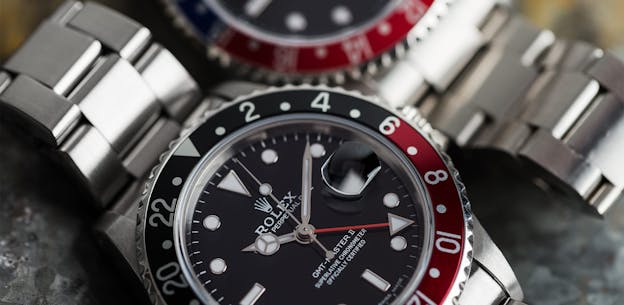History of the Rolex GMT-Master Collection and it’s Evolution to Today’s Modern Sports Watch
Few Rolex watches out there have maintained such long-standing desirability as the GMT-Master (now GMT-Master II). It’s one of the few watches out there where two words unrelated to its brand or model name will immediately make the watch come to mind. Should you utter the words “Pepsi bezel” in a crowd of watch collectors, every person there will (or at least should) know that you’re talking about the GMT-Master in its blue/red bezel configuration.

The Rise of an Icon
How did it reach this level of glory? Well it all starts back in the ‘50s. We aren’t going to go through this item by item, reference by reference, but rather will discuss the key highlights and changes through the GMT-Master’s extensive history.
The Beginning: Rolex and Pan-Am in the 1950s
It came to be as a commission/request from Pan-Am for a proper pilot’s watch. Not like what emerged from the early days of aviation of the dark days of war, but with commercial flight taking hold it was time for a practical watch capable of displaying a second time zone. While the current version can technically display three time zones (more on that in a bit) the first version–known as the reference 6542–was simpler in execution.

Image from Rolex.com
Its 24h hand was directly linked to your home time, and simple turn of the bi-directional bezel in either direction could quickly indicate the current time so long as you knew how many zones you’d hopped. Though the production run of this reference carried on until 1959, the most desirable of the pack (and the hardest to find in unbroken condition) are the models from the first two years of production. These came equipped with beautiful but fragile bakelite bezel inserts, which were and are notorious for cracking and shattering. After the first two years Rolex switched to aluminum, which was the standard for decades thereafter.
The Classic Era GMT-Master
There have been a few Rolex references that maintained long production runs, and the ref. 1675 GMT-Master is definitely one of them. Remaining in production from 1959 to 1980, the 1675 had a number of variations and updates over the years. This is where we saw the introduction of the “Root Beer” GMT, featuring a brown and yellow bezel and a brown dial. This was also the era of the “nipple dial” that occasionally appeared. This model would have less luminous and larger/more raised applied hour indices.

Its movement also evolved during this time frame; the 1565 automatic caliber was replaced by the 1575 in 1965, increasing its running frequency from 18,000vph to 19,600. Hacking seconds arrived in an upgrade to the 1575 by the early ‘70s. It’s also worth noting a key case change between the first and second references. The first GMT-Master case did not have crown guards, but they did get added to the ref. 1675 models.
Transitions To Modern
From 1980 through to present day, the changes in the GMT-Master came relatively swiftly. The reference 16750 arrived sporting a glossy dial and updated caliber–one which added a quick-set date function and a running frequency of 28,800vph. This caliber 3075 still meant that the home time and 24h time were intrinsically linked.

It wasn’t until 1983, when the arrival of the GMT-Master II added a quick-set jumping hour function, which meant that finally you could set your home and away time separately. Its initial production run spanned from 1983 to 1988, and was known as “the fat lady”–a nomenclature derived from its thicker than standard case proportions. Oddly this reference only appeared with a red/black “Coke bezel” rather than the more common and popular Pepsi variant. Its larger proportions were mostly attributed to the thickness of its caliber 3085, which was promptly replaced by the 3185 in 1989. The 1989 reference 16710 trimmed this case size back to less portly dimensions. From 1989 until 2007 the Pepsi bezel 16710 remained in production, again with some minor tweaks before being discontinued altogether.

Enter Cerachrom Phasing out Aluminum
It was a mere matter of time before Cerachrom–Rolex’s proprietary ceramic bezel material–became part of the equation. From 2008 through 2019, the 116710LN (a black ceramic bezel GMT was a mainstay of the line, but it took until 2018 for Rolex to finally deliver collectors the ceramic Pepsi bezel that countless Rolex enthusiasts had long been pining for. The 126710BLRO was what the people wanted, though there were a few additional teasers along the way. The beloved Batman GMT, the 116710BLNR arrived in 2013, and though it was a bit of an unexpected offering it was certainly a popular one. A year later in 2014 the first ceramic Pepsi GMT did arrive as the reference 116719BLRO, however not exactly as expected. Before bringing the steel model to market, Rolex opted for a more exclusive Pepsi offering in white gold.

And Now?
As always the big question with Rolex becomes “what comes next?”. Some (ok, many) are speculating that we will see a return of the Coke bezel in the coming years, but given how the brand has been making their steel models more and more scarce of late, I can’t help but speculate that they won’t be in any kind of rush to push that to market just yet. We’ll just have to wait and see!


